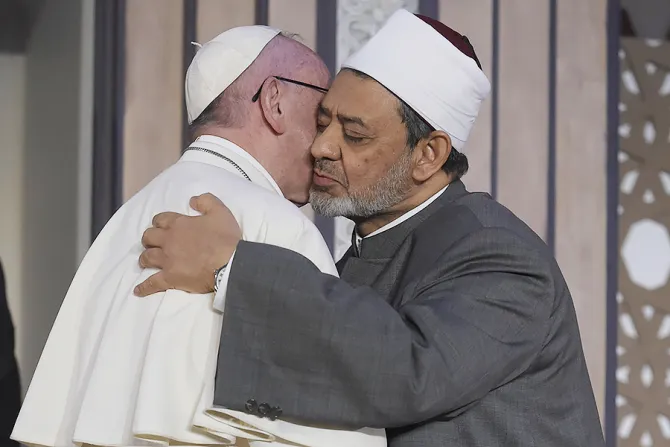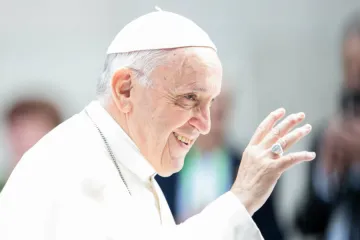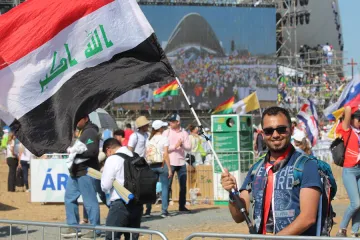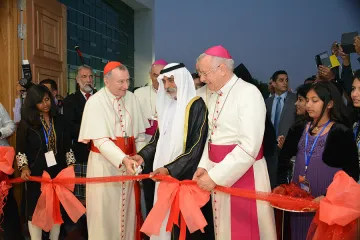Vatican City, Feb 2, 2019 / 06:01 am
Pope Francis is set to celebrate the first papal Mass on the Arabian peninsula next week during his Feb. 3-5 visit to Abu Dhabi, capital of the United Arab Emirates.
The pope's Mass at the Zayed sports stadium on Feb. 5 is expected to draw at least 135,000 people. Many in attendance will be migrant workers from Asia residing in the UAE, a country in which 89 percent of the population are not citizens. It will not only be the first papal Mass on the peninsula, but the first public Mass in the country.
Since the Second Vatican Council there have been significant milestones in Muslim-Catholic relations in the region. Here is a look at some of the highlights:
First pope on a plane
The first time a pope ever traveled on a plane was on a trip to the Middle East. Saint Paul VI flew from Italy to Jordan in January 1964, making history as the first pope to leave Europe. Paul VI met with King Hussein in Amman before continuing his journey to Jerusalem.
The following year, Paul VI issued Nostra aetate, the Second Vatican Council's declaration on the relation of the Church to non-Christian religions, which stated that "the Church looks upon Muslims with respect" as worshipers of the one God.
First pope in a mosque
Saint John Paul II made history as the first pope to enter a mosque during his visit to Syria in May 2001. John Paul II went to Damascus' Umayyad Mosque, which had been built in 715 on top of a fourth-century Christian cathedral said to contain the head of John the Baptist.
In March 2003, days before US President George W. Bush announced the official start of the Iraq war, St. John Paul II called for a worldwide fast for peace in the Middle East.
The Polish pontiff, known for his extensive papal travels during his 27-year pontificate, was also the first pope to visit several Middle Eastern nations, including Egypt, Lebanon, Syria, and Turkey.
First synod for the Middle East
Benedict XVI called for the first special Synod of Bishops focused on the Middle East over two weeks in October 2010. His post-synodal apostolic exhortation, Ecclesia in Medio Oriente, focused on the role of Christians living in the Middle East, predicting before the Arab Spring that many Christians would face a decision to emigrate due to the changing political situation in their countries or to remain as a witness to the faith.
Benedict XVI also added Arabic as one of the official languages in his weekly General Audience addresses in St. Peter's Square. His final papal trip was to Lebanon in 2012, the first papal trip to the region following the outbreak of the Arab Spring.
First papal Mass in Arabia
Pope Francis' trip to the United Arab Emirates Feb. 3-5 will be the first papal trip to the Arabian peninsula. The focus of the pope's two-day visit will be interreligious dialogue, particularly with Islam. However, the papal Mass will also make history as the first public outdoor Mass on the peninsula, where each country has restrictions on the freedom of worship.
Pope Francis said that he hopes his trip to Abu Dhabi will be "a new page in the history of the relations between the religions" in the region. During the journey Francis will meet the Great Imam of al-Azhar for the fifth time and will also visit the great mosque of Abu Dhabi.
(Story continues below)
The UAE trip continues Pope Francis' emphasis on a culture of encounter and interreligious dialogue. Pope Francis previously visited Egypt in 2017 and plans also to visit Morocco March 30-31.
History still to be made
The Middle Eastern countries of Iraq, Saudi Arabia, Yemen, Oman, Kuwait, Qatar, and Bahrain have yet to receive a papal visit.
On the way to World Youth Day in January, Pope Francis expressed his desire to visit Iraq, but noted that the local bishops have made it clear the country is not yet secure enough for a papal visit.
In Bahrain, construction is underway for the biggest Catholic cathedral in the region, due to be completed in January 2021. The mother church of the Vicariate Apostolic of Northern Arabia will be the first consecrated under the title Our Lady of Arabia.






